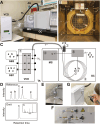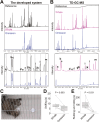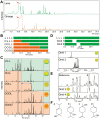Development of the gas chromatography/mass spectrometry-based aroma designer capable of modifying volatile chemical compositions in complex odors
- PMID: 38386845
- PMCID: PMC11812034
- DOI: 10.1093/chemse/bjae007
Development of the gas chromatography/mass spectrometry-based aroma designer capable of modifying volatile chemical compositions in complex odors
Abstract
Many volatile organic compounds (VOCs) are used to produce various commercial products with aromas mimicking natural products. The VOCs responsible for aromas have been identified from many natural products. The current major strategy is to analyze chemical compositions and aroma qualities of individual VOCs using gas chromatography/mass spectrometry (GC/MS) and GC-olfactometry. However, such analyses cannot determine whether candidate VOCs contribute to the characteristic aroma in mixtures of many VOCs. In this study, we developed a GC/MS-based VOC collection/omission system that can modify the VOC compositions of samples easily and rapidly. The system is composed of GC/MS with a switching unit that can change gas flow routes between MS and a VOC collection device. We first applied this system to prepare gas samples for omission tests, and the aroma qualities of VOC mixtures with and without some VOCs were evaluated by panelists. If aroma qualities were different between the 2 samples, the omitted VOCs were likely key odorants. By collecting VOCs in a gas bag attached to the collection device and transferring some VOCs to MS, specific VOCs could be omitted easily from the VOC mixture. The system could prepare omission samples without chemical identification, preparation of each VOC, and laborious techniques for mixing VOCs, thus overcoming the limitations of previous methods of sample preparation. Finally, the system was used to prepare artificial aromas by replacing VOC compositions between different samples for screening of key odorants. In conclusion, the system developed here can improve aroma research by identifying key odorants from natural products.
Keywords: aroma; gas chromatography/mass spectrometry; key odorants; omission test; volatile organic compound.
© The Author(s) 2024. Published by Oxford University Press. All rights reserved. For permissions, please e-mail: journals.permissions@oup.com.
Conflict of interest statement
Masao Miyazaki have patent applications covering the developed system and method (patent application 6807587 and 6807587). The authors declare that they have no other competing interests.
Figures





Similar articles
-
Characterization of the key aroma compounds in Longjing tea using stir bar sorptive extraction (SBSE) combined with gas chromatography-mass spectrometry (GC-MS), gas chromatography-olfactometry (GC-O), odor activity value (OAV), and aroma recombination.Food Res Int. 2020 Apr;130:108908. doi: 10.1016/j.foodres.2019.108908. Epub 2019 Dec 18. Food Res Int. 2020. PMID: 32156355
-
Identification of aroma-active compounds responsible for the floral and sweet odors of Congou black teas using gas chromatography-mass spectrometry/olfactometry, odor activity value, and chemometrics.J Sci Food Agric. 2022 Sep;102(12):5399-5410. doi: 10.1002/jsfa.11893. Epub 2022 Apr 20. J Sci Food Agric. 2022. PMID: 35332546
-
Characterization of key aroma compounds from different rose essential oils using gas chromatography-mass spectrometry, gas chromatography-olfactometry and partial least squares regression.Nat Prod Res. 2018 Jul;32(13):1567-1572. doi: 10.1080/14786419.2017.1389933. Epub 2017 Oct 25. Nat Prod Res. 2018. PMID: 29067827
-
A Narrative Review of the Current Knowledge on Fruit Active Aroma Using Gas Chromatography-Olfactometry (GC-O) Analysis.Molecules. 2021 Aug 26;26(17):5181. doi: 10.3390/molecules26175181. Molecules. 2021. PMID: 34500614 Free PMC article. Review.
-
Review of the Aroma Chemistry of Pineapple (Ananas comosus).J Agric Food Chem. 2023 Mar 8;71(9):4069-4082. doi: 10.1021/acs.jafc.2c08546. Epub 2023 Feb 24. J Agric Food Chem. 2023. PMID: 36827381 Review.
Cited by
-
Identification of Volatile Organic Compounds and Analysis of Aroma Characteristics in Ten Pear Syrups.Foods. 2024 Oct 10;13(20):3223. doi: 10.3390/foods13203223. Foods. 2024. PMID: 39456284 Free PMC article.
References
-
- Acree T, Barnard J, Cunningham D. A procedure for the sensory analysis of gas chromatographic effluents. Food Chem. 1984:14(4):273–286.
-
- Arora G, Cormier F, Lee B. Analysis of odor-active volatiles in Cheddar cheese headspace by multidimensional GC/MS/sniffing. J Agric Food Chem. 1995:43(3):748–752.
-
- Baldovini N, Chaintreau A. Identification of key odorants in complex mixtures occurring in nature. Nat Prod Rep. 2020:37(12):1589–1626. - PubMed
-
- Block E. Molecular basis of mammalian odor discrimination: a status report. J Agric Food Chem. 2018:66(51):13346–13366. - PubMed
Publication types
MeSH terms
Substances
Grants and funding
LinkOut - more resources
Full Text Sources
Miscellaneous

